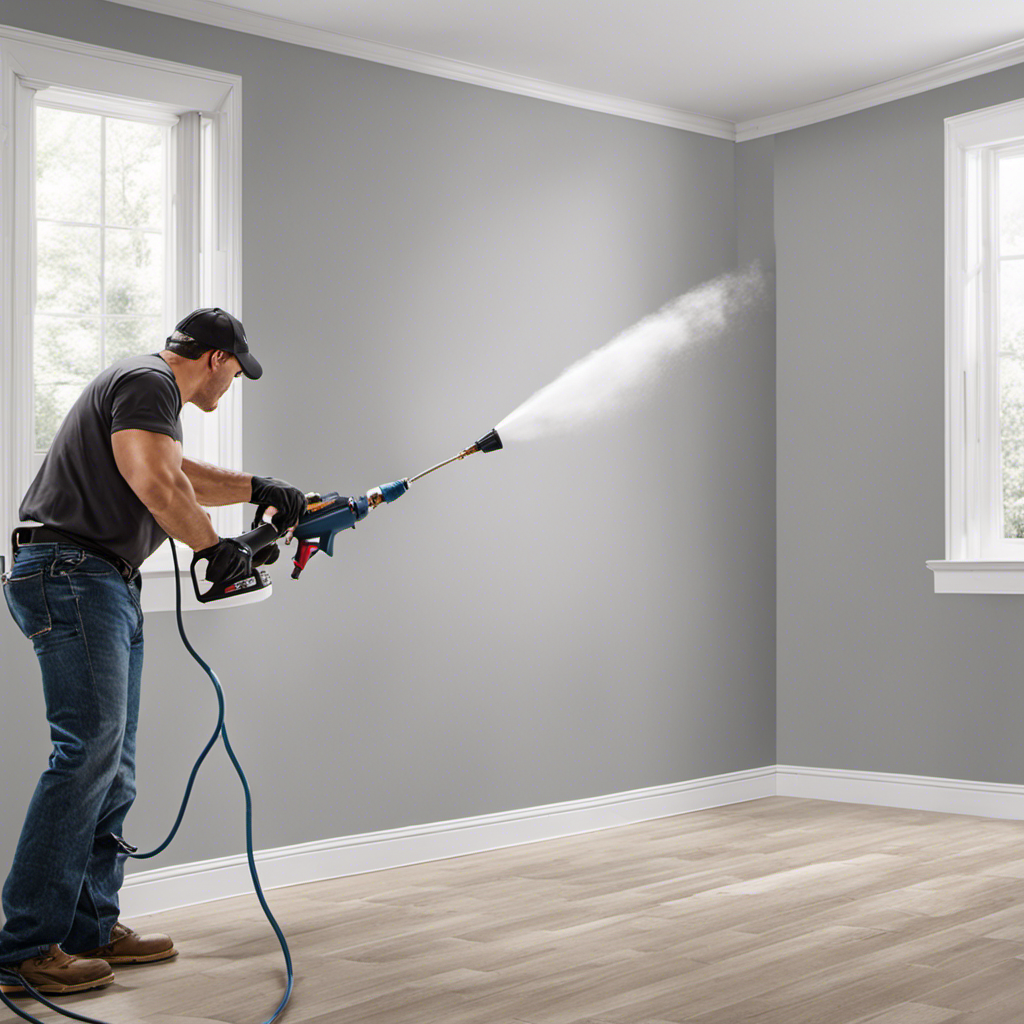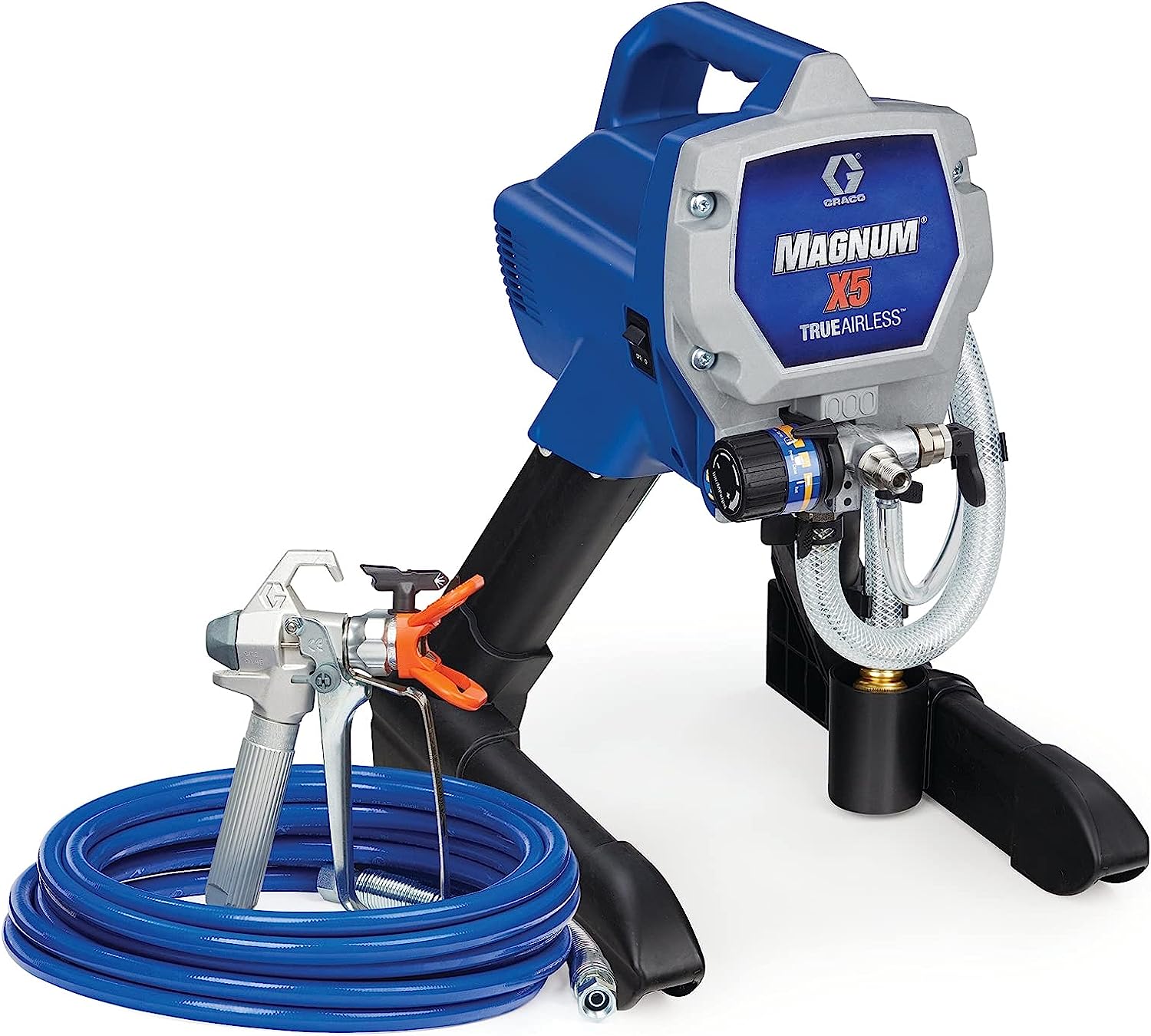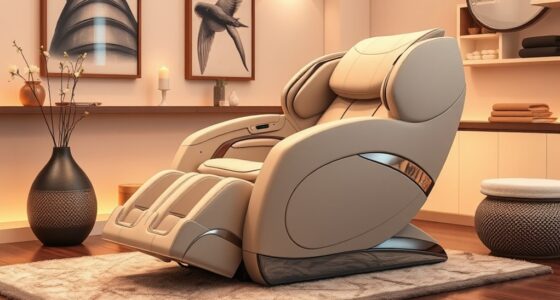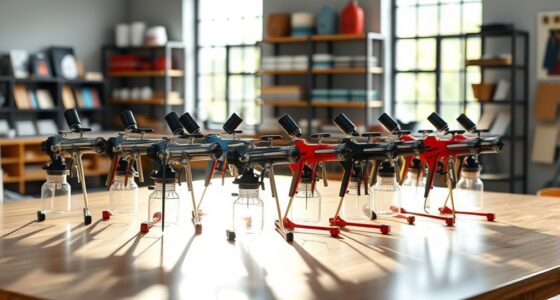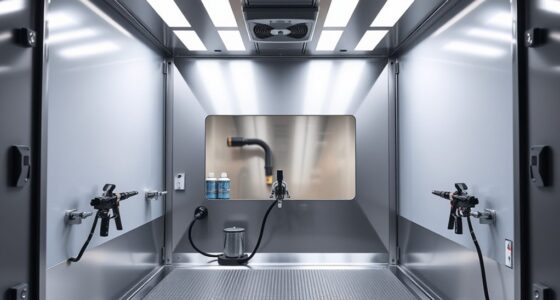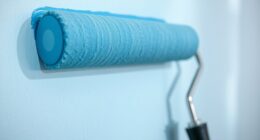When searching for the perfect airless paint sprayer for indoor walls and trim, it is crucial to take into account a few essential factors.
For example, imagine a homeowner who wants to give their living room a fresh coat of paint, but doesn’t want to spend hours with a brush and roller. They need a solution that offers a smooth and even finish, saves time, and is versatile for different projects.
This is where an airless paint sprayer comes in.
In this article, we will explore the benefits, drawbacks, and important considerations when choosing the perfect airless paint sprayer for interior walls and woodwork.
Key Takeaways
- Airless paint sprayers offer professional-looking finishes and save time.
- Considering project size, type, and budget is important when choosing an airless paint sprayer.
- Proper surface preparation is crucial for achieving a smooth result on interior walls and woodwork.
- Researching and comparing different brands and models helps in selecting the perfect airless paint sprayer.
Benefits of Airless Paint Sprayers
Airless paint sprayers offer a smooth and even finish, saving time and providing versatility for various interior wall and woodwork projects. One of the biggest benefits of airless paint sprayers is the ability to achieve a professional-looking finish. Unlike traditional brushes or rollers, airless sprayers atomize the paint into fine particles, resulting in a smooth and even application. This not only saves time but also creates a more uniform finish.
Additionally, airless sprayers are versatile and can be used for a wide range of projects, from painting walls to staining woodwork. However, there are some drawbacks to consider. Airless sprayers can be noisy, require frequent cleaning, and have a steeper learning curve compared to other painting methods. Despite these drawbacks, the benefits of airless paint sprayers make them a popular choice for professionals and DIY enthusiasts alike.
Drawbacks of Airless Paint Sprayers
Despite their benefits, airless paint sprayers have some drawbacks that should be considered when deciding whether to invest in one for your painting projects.
One of the main drawbacks of airless paint sprayers is the need for frequent cleaning. These machines can become clogged with paint, requiring regular maintenance to keep them functioning properly. Additionally, the high-pressure system can create a loud and disruptive noise during operation, which may be a concern for those working in residential areas or sensitive environments.
Another drawback is the steeper learning curve associated with using airless paint sprayers. These machines require proper technique and skill to achieve a smooth and even finish. Beginners may find it challenging to control the spray pattern and pressure, resulting in uneven coverage or overspray.
Despite these drawbacks, many professionals and DIY enthusiasts still find airless paint sprayers to be a valuable tool for their painting projects. With proper maintenance and practice, the benefits can outweigh the drawbacks, making airless paint sprayers a worthwhile investment.
Project Size and Type Considerations
When considering project size and type, individuals should take into account the surface they are working on and the amount of paint needed. These factors play a significant role in determining the right airless paint sprayer for the job. To help make an informed decision, it is important to consider project budget considerations and the environmental impact.
| Project Size | Surface Type | Amount of Paint Needed |
|---|---|---|
| Small | Interior | Less than 1 gallon |
| Medium | Exterior | 1-3 gallons |
| Large | Woodwork | 3-5 gallons |
Surface Preparation for Interior Walls and Woodwork
To ensure a smooth and long-lasting finish, individuals must properly prepare the surface of their interior walls and woodwork before applying paint. Here are some surface preparation techniques and common mistakes to avoid:
-
Clean the surface thoroughly: Remove any dirt, dust, or grease using a mild detergent and water solution. Rinse and allow it to dry completely.
-
Repair any damages: Fill in cracks, holes, or imperfections using spackle or wood filler. Sand the repaired areas to create a smooth surface.
-
Sand the surface: Use sandpaper or a sanding block to lightly sand the walls and woodwork. This helps to remove any roughness and promote better paint adhesion.
-
Prime the surface: Apply a coat of primer to seal the surface and ensure proper paint adherence. This also helps to cover any stains or discoloration.
Common mistakes to avoid include skipping the cleaning step, not repairing damages properly, inadequate sanding, and forgetting to prime the surface.
Researching and Comparing Brands and Models
Individuals can save time and make an informed decision by researching and comparing different brands and models of airless paint sprayers. By utilizing various researching techniques and comparing customer reviews, individuals can gather valuable information to help them choose the perfect airless paint sprayer for their interior walls and woodwork projects.
To assist in the research process, a table can be used to compare different brands and models based on specific criteria. This table provides an organized and efficient way of evaluating the options available.
| Criteria | Brand A | Brand B | Brand C |
|---|---|---|---|
| Adjustable Pressure | Yes | Yes | Yes |
| Durability | High | Medium | High |
| Ease of Cleaning | Easy | Medium | Easy |
| Customer Reviews | 4.5 out of 5 stars | 4 out of 5 stars | 4.5 out of 5 stars |
Adjustable Pressure Settings for Customization
The adjustable pressure settings on airless paint sprayers allow users to customize the spray pattern and pressure to achieve their desired results. This feature offers several advantages:
-
Increased control: With adjustable pressure, users can have precise control over the amount and speed of paint being sprayed. This allows for better coverage and reduces the risk of overspray.
-
Versatility: Different projects and surfaces require different pressure levels. Adjustable pressure settings make it easy to switch between low and high-pressure applications, making airless paint sprayers suitable for a wide range of tasks.
-
Adaptable spray patterns: By adjusting the pressure, users can change the spray pattern from a narrow stream to a wide fan. This versatility allows for more flexibility in achieving different finishes and effects.
-
Improved efficiency: The ability to customize pressure settings ensures optimal paint application, reducing waste and saving time during the painting process.
To make the most of adjustable pressure settings, here are a few tips:
-
Start with a lower pressure setting and gradually increase it until the desired coverage is achieved.
-
Test the spray pattern on a scrap surface before starting the actual project to ensure it meets your expectations.
-
Adjust the pressure according to the type of paint being used and the surface being painted. Thicker paints may require higher pressure, while delicate surfaces may need lower pressure to avoid damage.
-
Clean the sprayer thoroughly after each use to prevent clogs and maintain consistent performance.
Durable and Easy-to-Clean Design
A durable and easy-to-clean design is essential for ensuring the longevity and maintenance of an airless paint sprayer. When it comes to painting furniture, having a sprayer with these features can provide numerous benefits.
Firstly, a durable design ensures that the sprayer can withstand the wear and tear of regular use without breaking down. This is especially important when painting furniture, as it often involves maneuvering the sprayer in various angles and positions.
Secondly, an easy-to-clean design allows for quick and efficient cleaning after each use, preventing paint buildup and clogging. This not only saves time but also extends the lifespan of the sprayer.
Overall, a durable and easy-to-clean design in an airless paint sprayer is crucial for achieving high-quality results and maintaining the efficiency of the equipment.
Electric Vs. Gas-Powered Sprayers
When deciding between electric and gas-powered sprayers, it’s important to consider the specific needs of the project and the level of power required. Here are some pros and cons of each:
-
Electric sprayers are cost-effective, as they consume less energy and have lower operating costs. They are also quieter and produce fewer emissions. However, they may have limited power and require access to a power source.
-
Gas-powered sprayers offer more power and are ideal for larger projects or outdoor use. They provide greater mobility and can handle thicker coatings. However, they are generally more expensive to purchase and maintain, and they produce noise and emissions.
In terms of cost-effectiveness, electric sprayers may be a better option for smaller projects or those with limited power needs, while gas-powered sprayers are more suitable for heavy-duty and large-scale applications where power is crucial.
Ultimately, the choice depends on the specific requirements and budget of the project.
Additional Features and Accessories to Look For
Adjustable pressure settings, built-in filter systems, and the ability to choose the right nozzle size are important features to look for when considering additional accessories for an airless paint sprayer. These features allow for greater control and precision during paint application.
When exploring paint color options, having the ability to adjust the pressure settings ensures that the paint is applied evenly and smoothly, regardless of the color or type of paint being used. The built-in filter system helps to prevent clogs and ensures that the paint is free from debris, resulting in a professional-looking finish.
Understanding paint application techniques is essential in achieving the desired results. By being able to choose the right nozzle size, users can tailor the spray pattern and coverage to suit their specific project, whether it’s a large wall or intricate woodwork.
Choosing the Right Nozzle Size
The right nozzle size is crucial for achieving the desired spray pattern and coverage when using an airless paint sprayer. To choose the correct nozzle size, consider the following factors:
-
Project requirements: Different projects may require different nozzle sizes to achieve the desired result. For instance, larger surfaces may benefit from a wider spray pattern, while intricate details may require a smaller nozzle.
-
Paint type: Different paint types have varying viscosities. Thicker paints may require a larger nozzle size to ensure proper atomization, while thinner paints may work well with a smaller nozzle.
-
Maintenance tips: It’s important to clean the nozzle regularly to prevent clogging and maintain optimal performance. Follow the manufacturer’s instructions for cleaning and maintenance to prolong the lifespan of your airless paint sprayer.
Exploring Different Paint Finishes
Different paint finishes can add depth and texture to surfaces, allowing for a variety of aesthetic options.
When exploring different paint finishes, there are several tips to keep in mind for achieving a professional finish.
First, it’s important to properly prepare the surface by cleaning and priming it before applying any paint. This will ensure that the paint adheres well and results in a smooth, even finish.
Next, choosing the right type of paint for the desired finish is essential. For example, a satin or semi-gloss finish is often used for high-traffic areas as it is more durable and easier to clean.
Finally, using the right tools, such as high-quality brushes or rollers, can also contribute to achieving a professional finish.
Comparing Prices for Value for Money
When comparing prices for value for money, it’s important to consider the overall durability and maintenance requirements of the airless paint sprayer. Factors to consider when comparing prices for value for money include:
-
Performance: Look for sprayers that offer consistent and reliable performance, ensuring that you get the desired results for your projects.
-
Quality: Higher-priced sprayers often come with better build quality and materials, resulting in a longer lifespan and fewer repairs or replacements.
-
Warranty: Consider the warranty offered by the manufacturer, as it can provide peace of mind and protection against any potential defects or malfunctions.
-
Long-term costs: While a lower-priced sprayer may be more affordable upfront, it’s essential to evaluate the long-term costs associated with maintenance, replacement parts, and repairs.
Analyzing Durability and Maintenance Requirements
To analyze durability and maintenance requirements, one should consider the overall build quality and materials used in the airless paint sprayer.
The durability of the sprayer is crucial for long-term use and to ensure it can withstand frequent use without breaking down. It is important to assess the materials used in the construction of the sprayer, as high-quality materials will contribute to its durability.
Maintenance costs should also be taken into consideration. Some sprayers may require regular maintenance and replacement parts, which can add to the overall cost of ownership.
Finding a Balance Between Price and Quality
Finding a balance between price and quality is essential when selecting an airless paint sprayer. To ensure you make the best choice, consider weighing affordability and long-term investment.
Here are some factors to keep in mind:
- Research and compare different brands and models to find the best value for your money.
- Consider the upfront cost, but also analyze the overall durability and maintenance requirements of the sprayer.
- Look for adjustable pressure settings that allow you to customize the spray pattern and pressure for different projects.
- Check for a durable and easy-to-clean design, as this will save you time and money in the long run.
Frequently Asked Questions
Can an Airless Paint Sprayer Be Used on Both Interior Walls and Woodwork?
Yes, an airless paint sprayer can be used on both interior walls and woodwork. The spray method offers several advantages over using a brush, including a more even and professional finish, time-saving capabilities, and versatility for various projects.
To achieve a smooth finish with an airless paint sprayer on interior walls and woodwork, it is essential to properly prepare the surfaces, adjust the pressure settings to customize the spray pattern, and choose the right nozzle size.
How Do I Know What Pressure Setting to Use for Different Types of Projects?
When it comes to choosing the correct pressure setting for different projects with an airless paint sprayer, there are a few tips to keep in mind.
First, consider the type of surface you are painting. For rough surfaces, a higher pressure setting may be needed to ensure proper coverage.
For smoother surfaces, a lower pressure setting can help achieve a more even finish.
Additionally, experimenting with different pressure settings and practicing on a test surface can help you determine the ideal pressure for your specific project.
What Are the Most Important Factors to Consider When Choosing a Brand and Model of Airless Paint Sprayer?
When choosing the right brand and model of airless paint sprayer, there are several important factors to consider.
First, think about the size and type of your project, as well as the surface preparation required.
Research and compare different brands and models to find the best fit for your needs.
Look for adjustable pressure settings to customize the spray pattern and pressure.
Additionally, check for a durable and easy-to-clean design.
These factors will help you make an informed decision when selecting an airless paint sprayer.
Are There Any Specific Surface Preparation Steps That Are Necessary for Interior Walls and Woodwork?
Surface preparation is essential for achieving a professional-looking paint job on interior walls and woodwork. Before painting, it’s important to clean the surfaces thoroughly to remove any dirt, dust, or grease.
Fill in any holes or cracks with spackling compound and sand the surfaces to create a smooth finish. Prime the walls and woodwork to ensure proper adhesion of the paint.
Taking these steps will result in a clean and flawless paint application.
What Are Some Common Maintenance Requirements for Airless Paint Sprayers?
Airless paint sprayers require regular maintenance to ensure optimal performance and longevity. Cleaning procedures involve flushing the system with cleaning solution after each use and removing any clogs or debris from the nozzle.
Troubleshooting tips may include checking for leaks, inspecting the pump for any damage, and ensuring proper lubrication of moving parts. Regular inspection and maintenance of filters, hoses, and seals are also important to prevent any issues during operation.
Conclusion
In conclusion, when choosing the perfect airless paint sprayer for interior walls and woodwork, it is important to carefully consider all the factors involved.
While airless paint sprayers offer benefits such as a smooth and even finish, time-saving capabilities, and versatility, they also come with drawbacks such as noise and frequent cleaning.
By researching and comparing different brands and models, considering project size and type, and analyzing durability and maintenance requirements, one can find the right balance between price and quality.
By investigating the truth of theories and providing informative and detailed information, this conclusion adds depth to hook the audience.
A seasoned painter with over 15 years in the industry, Mike transitioned from hands-on painting projects to the digital world of paint sprayers. His extensive experience gives him a unique perspective on what users truly need when it comes to painting tools. As the Editor in Chief of Paint Sprayer Zone, Mike ensures that every piece of content not only provides value but also reflects the realities of painting — the challenges, the joys, and the intricate details.
